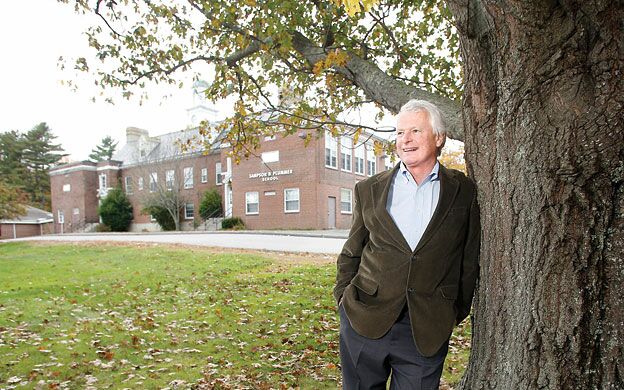Maine developers lead the effort to reuse shuttered schools
The 40-year history of Avesta Housing's efforts to create affordable housing in southern Maine is neatly laid out in several rows of framed photographs hanging in the front lobby of the nonprofit's headquarters in Portland.
They start with single-family housing projects funded in the 1970s and '80s, when readily available federal money encouraged developments in rural areas where land was cheap and available but often far removed from jobs, grocery stores, doctor's offices and other public services. By contrast, the most recent projects in Avesta's $130 million housing portfolio — the $6 million Emery School conversion in Biddeford and the $7.8 million renovation of Park Street School in Kennebunk — represent a sea change in the agency's thinking about affordable housing.
The Portland-based agency, which is one of the largest nonprofit developers of affordable housing in New England, is marketing the 24 Emery School apartments for people 55 and older, with monthly rents from $637 to $918. Park Street's 30 apartments will house people 62 and older or who are handicapped, with rents from $765 to $918. Both involved extensive renovations of historic school buildings with solid brick facades, high ceilings, tall windows and original classroom chalkboards that have been incorporated into the décor of completed apartments.
In Maine, where shrinking enrollment and an aging population mean more schools are becoming empty at a time when many older residents are looking to downsize and move into smaller living quarters, shuttered schools have emerged as prime candidates for senior housing. At least eight historic schools in the last five years have been converted, or are in various stages of completion.
It's all part of a national trend in which many towns and cities are finding that the most financially feasible reuse of old school buildings is housing.
Dana Totman, who came to Avesta 12 years ago after a six-year stint at Maine Housing Authority, says the movement away from new construction toward reusing older buildings — especially older schools typically located close to downtown amenities — reflects a gradual evolution in thinking about how best to meet the needs of the low-income, handicapped and senior populations his agency serves.
"We embrace 'smart growth' principles," says Totman. "We want to build housing in the center of communities … When I first got here I visited a couple of projects we were seeking approval for — both were very much out of town. It didn't feel right. I felt like we were isolating low-income residents in these [far-removed] places. It was a bit of a jolt, coming from MSHA where I had seen other communities latching onto reusing, repurposing buildings in their downtowns. I liked that concept better. It seemed right."
Changing demographics
Totman and Avesta Housing are not alone in that way of thinking.
For-profit developer John Wasileski, who is in the early phases of a 10-year redevelopment project involving two schools adjacent to his OceanView at Falmouth retirement community, sees the same principles at play, even though his project is located in a more rural setting than the two school conversions Avesta completed this summer.
"I'm a great proponent of using older historic structures and converting them to new uses, especially residential," says Wasileski, now in his 28th year at OceanView who also developed two retirement housing communities in Topsham.
In Wasileski's case, OceanView's $3.25 million purchase of the two school properties from Falmouth this year adds just under 20 acres to his 60-acre retirement community. The first phase includes a three-building luxury apartment complex (with 34 apartments to be priced in the upper $400,000 range); later phases call for construction of 35 highly energy-efficient homes, priced at $500,000, and an expansion of the main lodge, adding up to 20 large apartments priced in the mid-$400,000 range.
His plans for the Lunt and Plummer-Motz schools — which closed in June 2011 to make way for the opening of the new Falmouth Elementary School that September — involve a phased public-private partnership with Falmouth that would include a new auditorium in the Lunt School, creation of a community center in a renovated, expanded or redeveloped Motz school site, and the possible relocation of the Falmouth Memorial Library to a renovated and expanded Plummer School, according to a project summary provided by OceanView.
Other aspects of the projected $35 million project include renovating the Lunt School to house various services such as an adult day care program and a physical and occupational therapy office. A new "memory support" assisted-living facility, with 24 rental apartments designed to meet the needs of residents with Alzheimer's disease, would be built sometime next year behind the Lunt School.
"What our OceanView residents want is to be a part of the community, not apart from it," Wasileski says regarding the planned public elements of the Falmouth schools redevelopment project.
Tear down, or reuse?
Closed schools, especially those that are solid, centrally located, historically significant and eligible for historic preservation tax credits are prime candidates for conversion. Their proximity to downtowns and close-knit neighborhoods that made it possible for children to walk to and from school, Totman says, is equally desirable to Avesta's typical renters. He cites Avesta's study of several school reuse projects that found the average commute of residents dropped from 9 miles to 2 miles after they'd moved in. Even more telling, he says, 40% were able to walk to work.
But that doesn't mean housing will be the first choice for a community closing an old school — particularly if there's a lot of history attached to the building.
Totman says Avesta has learned it's important to let the community decide the best reuse of an older school building, noting that it's common for residents initially to explore preserving it for public use only to arrive at the conclusion that they can't afford the inevitable renovation costs.
In the case of the Emery School in Biddeford, several elements lined up to make affordable housing a prime reuse candidate. Built in 1913 by the prominent Portland architecture firm Miller & Mayo, it is a classic Georgian Revival-style brick building eligible for the historic preservation tax credit that has become a key element of financing reuse projects involving older buildings.
It served as a school until 1993, when it was converted into a child development center run by Catholic Charities of Maine. In 2007 it became vacant once again, creating a dilemma for the city of Biddeford: Tear it down, reuse or sell it to a developer?
An architectural design and engineering firm hired by Biddeford to assess the city's buildings concluded in 2006 the school would need $1.9 million in renovations to achieve code compliance and upgrade the facility's heating, plumbing and electrical systems and fixtures. That study gave Avesta and other would-be developers a solid understanding of what they might be getting into if they took on the project of converting Emery School into housing.
Here is where Totman gives high marks to Biddeford city officials and the city council for supporting them: Instead of allowing the vacant school to decay, they spent between $15,000 to $20,000 per year for utilities and services to provide minimal heating and security for the building. That investment, he says, preserved the conversion of the Emery School to housing as a viable option.
"As towns go through those difficult deliberations, someone needs to keep an eye on the clock," Totman adds, citing Brunswick's eventual decision to tear down its old high school after it sat more or less vacant for more than a decade. "Even if it's heated, time and vacancy lead to extra expenses and make the building susceptible to vandalism. The longer these old schools sit vacant, the harder they become to convert."
Federal funding, and a town's willingness to partner with a would-be developer, are other variables that often leverage a successful conversion of an old school building into affordable housing.
John Hodge, executive director of the Brunswick Housing Authority, recently completed a $3 million renovation of the old Lisbon High School, a two-story brick Romanesque Revival structure built in the early 1900s that's listed on the National Register of Historic Places. Closed when the new high school opened in 1952, he says the building had a second life as a superintendent's office but had been shuttered for several years when it came to his attention shortly after the 2008 recession.
Hodge says Lisbon, like Biddeford with its shuttered Emery School, had kept the old Lisbon High School in good shape but was eager to find a suitable developer to take over the property … all the more so given the severity of the recession and the chill it had put on real estate projects in general. As luck would have it, he says, the state of Maine had received $20 million in federal stimulus money, to be disbursed regionally to stabilize neighborhoods with foreclosed or blighted properties. Lisbon's economic development director queried Hodge about whether a conversion of the old high school into senior housing might qualify as a "neighborhood stabilization project."
He checked with the Maine Department of Economic and Community Development and found that it would. Then he hired an architect to do a feasibility study that enabled Lisbon to win federal stimulus funds for the project. Coupled with state and federal tax credits and Lisbon's decision in 2009 to sell the old high school building to Brunswick Housing Authority for $1, Hodge knew he had a financially viable project and took it on.
"The common denominator in these school conversion projects is that housing is the one use that's not only readily needed but often also financially feasible," says Hodge, noting that eight of the 12 apartments have already been rented. "We couldn't be more pleased."
It takes a team
Providing affordable housing by converting older school buildings isn't a slam-dunk proposition, especially so because the state and historic preservation tax credits often used to make those projects feasible carry some pretty stringent requirements to preserve the building's historic integrity. It takes a team to pull it off, says Drew Sigfridson, a principal of CBRE|The Boulos Co. who also wears additional hats as president of Maine Real Estate & Development Association and as vice chairman of Avesta Housing's board of directors.
Sigfridson credits many partners that helped Avesta convert Emery School into 24 senior apartments, starting with Biddeford officials, its city council and planning board. They approved the zoning change, reached a tax increment financing agreement with Avesta and delivered planning board approval, he says, all in a "matter of months."
Kevin Bunker and his Developers Collaborative shared expertise in crafting public-private partnerships to get the job done, which included MaineHousing and general contractor AlliedCook Construction. Northern New England Housing Investment Fund provided assistance in pulling together funding for the project, including the various tax credit programs that comprise two-thirds of the financing. TD Bank made the construction loan.
State historian Earl Shettleworth and Tremont Preservation Services guided Archetype Architects and AlliedCook Construction from beginning to end, making sure the building's granite and cast stone trim and exterior red brick facade, as well as its original wood floors, tin ceilings and wood trim were preserved. Solar panels installed on the roof were kept hidden to preserve the building's historic appearance.
For Matt Cook, project executive for AlliedCook, the $4.5 million project was challenging — involving both asbestos removal and the extra care to preserve historic features — but a "nice project" to have at a time when commercial retail construction remains sluggish. In the last five years, he says, AlliedCook has completed five school-to-housing projects, three with Avesta (besides Emery School, it renovated the Shailer and Emerson schools in Portland, which already had been converted into housing in the 1980s).
"It seems to be a trend, taking these existing downtown properties and bringing them back to life," he says.
For Elaine Dubois, the conversion of the Emery School into housing brings her full circle. She remembers wandering away from her family's home on Summer Street at the age of 3 and "seeing all these kids" playing outside a big brick building. A bell rang and "the kids disappeared."
As she stood there wondering why, a police officer came by and not getting an answer from her where she lived, took her to the police station — first buying her a chocolate ice cream cone — where her relieved father eventually picked her up. He asked her why she wandered off, and she told him she "wanted to go to school to play with the big kids."
The family moved before she was old enough to attend Emery School. Now disabled, she met Avesta's rental guidelines and moved into her apartment in June.
"Finally, I got into the big school," she says. "And now I call it my home."















Comments